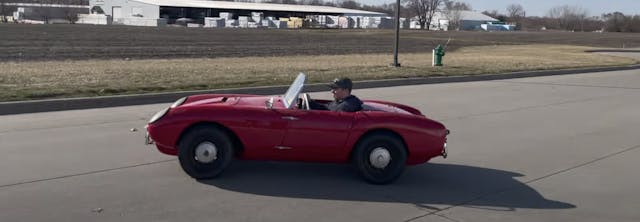Media | Articles
Is a 600-pound car with 328-cc, two-stroke engine just too goofy?
Sometimes it’s difficult to remember a time when the proposed solution to automotive problems was something other than electrification. Back in the mid-20th century, faced with traffic congestion and cramped parking, automakers built petite, maneuverable cars. For instance, this little 1956 Berkeley SE328 barely commands half a traffic lane. 65 years later, is this car just too goofy to succeed at anything?
The Berkeley puts the micro in microcar. Until you put a familiar vehicle next to it for scale, you’ll probably imagine the SE328 as Triumph Spitfire-sized. It’s certainly not. The wheelbase is a scant 68 inches, and overall width is barely over 4 feet. The proportions look right, though, and, once you understand how small the thing is, the powertrain begins to make sense.
Under the bonnet is a 328-cc two-stroke twin sourced from Excelsior. It puts out roughly 18 hp and powers the front wheels through a five-speed manual gearbox integrated into the engine. Interestingly, the gas tank sits just above the twin carburetors, which allows for a very small trunk (of sorts) behind the driver and passenger.
If the whole car seems a bit trivial, well, it was meant to be. Berkeley Cars was a partnership between designer Lawrence “Lawrie” Bond and Charles Panter, who owned the Berkeley Coachworks factory and is best known for for making camper trailers. Panter had experience with glass-reinforced plastic from his trailer business and wanted to take advantage of the seasonal downtime of the camper job. The first Berkeley cars rolled out in 1956 but, after an unfortunate downturn in the camper market four years later, the venture fell flat and the company went into liquidation in 1961. Roughly 4100 Berkeley cars were produced, almost all of them two-seat sporty models like the SE328.
The sound of the car running and driving is downright confusing for a motorcycle guy like myself. Cars just aren’t supposed to sound like that! It sure looks fun to drive, though, even if it would practically disappear into every blindspot of a modern truck or SUV. I guess maybe a local golf course might let you rally the cart paths after hours if you ask nicely. Probably not—but boy, would that be fun.
Marketplace
Buy and sell classics with confidence










